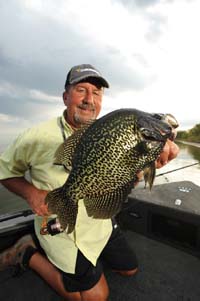Unique applications of the so-called ‘big fish’ line for crappies, perch and bluegills
by Mitch Eagan
 Certainly, the best way to decode what fish are keen on is covering as much water as possible with a multitude of baits. Unfortunately, though, it’s tedious and time consuming – virtually unrealistic. Meanwhile, back on earth, trolling, by far, is the best way to find fish while eliminating unproductive water. But by pulling lures with a conventional rod, reel and line combo, it’s physically impossible to sample the entire water column. And this time of year, fish of all species can be anywhere – high, low, or somewhere in-between.
Certainly, the best way to decode what fish are keen on is covering as much water as possible with a multitude of baits. Unfortunately, though, it’s tedious and time consuming – virtually unrealistic. Meanwhile, back on earth, trolling, by far, is the best way to find fish while eliminating unproductive water. But by pulling lures with a conventional rod, reel and line combo, it’s physically impossible to sample the entire water column. And this time of year, fish of all species can be anywhere – high, low, or somewhere in-between.
Fall is the perfect time to break out the leadcore line. With this one crucial piece of gear, lures of any stripe can be fished down to whatever depth is necessary. It’s a great tool for trolling clear or stained waters, whether windy or calm.
Great Lakes anglers have been targeting trout and salmon with it for decades, as well as walleye pros and fervent weekenders of the inland lakes and rivers. But these popular game fishes aren’t the only ones that’ll eat an offering trailing behind leadcore line. Pike, bass and even panfish can trolled-up with leadcore.
A Novel Idea
Leadcore is what its name dictates: a strand of the soft metal with threads of fabric woven around it for strength. It’s been around for decades, actually.
“My grandfather and I used to use it on the Great Lakes when I was a kid,” says Mark Martin, LUND Boats walleye tournament pro and Fishing/Vacation School instructor. “We caught everything on it while trolling with Rapala Original Minnows, from walleye to lake trout. Today I still use leadcore for trolling, no matter what species I’m after.”
To tell you the truth, what got me thinking about expanding my horizons with this tried and true method is a new version of the old standby. Just this year, Sufix introduced a new leadcore line—832 Advanced Lead Core, to be exact. Its lead has been wrapped with different material than conventional leadcore. And it’s making fishing with weighted line more versatile than ever.
The engineers at Sufix traded out the polyester fibers of standard ‘core with the sophisticated ones used in smash-hit 832 Advance Superline. This novel idea simultaneously increased the line’s sink rate and improved overall strength. Best of all, you can use lighter pound test while not losing a single foot of depth, and control. The amount of lead per foot is the same as the past, but the bulky diameter has been compressed. Subsequently, you can spool Sufix 832 Lead Core onto smaller reels and use lighter action rods. Plus, you can get smaller lures deeper with less line out.
“The Dyneema and Gore fibers don’t stretch like the old polyester ones do, which makes 832 Advanced Lead Core much more sensitive,” says Minnesota guide and Rapala pro angler, Tom Neustrom. I now have my clients hang onto the rod rather than set it in a holder. They can feel every wiggle of the lure, and know if it’s been fouled with weeds. And if something smacks the bait, we know it right away instead of dragging it around a while,” references Neustrom about how old clunky leadcore doesn’t always reveal that a small fish is being dragged along the surface like a fallen skier.
New Fish on the Line
As Neustrom told me about the superior sensitivity of Sufix’s new leadcore and how many panfish he’s hooked using it, my mind started reeling… The new line is perfect for driving lures down to panfish, which often hug the bottom in autumn. And because it can be used with lighter gear, reeling in a perch, ‘gill or crappie on ‘core will actually be entertaining.
Rapala’s new Ultra Light Minnow and Shad have a look and action panfish can’t resist. When pulling them with leadcore, I tether them to a 6-foot section 6- to 8-pound-test Suffix 100% Fluorocarbon Leader Line; the slightly heavier pound test to thwart line breakage when a toothed predator fish eats these tiny baits. And believe me, they will.
Another thing I’m fond of about the sophisticated new leadcore is that it can be knotted. I can attach the leader with a small ball-bearing swivel or InvisaSwivel rather than fumble-fingering a special tie, like you have to do with old school leadcore.
Rods with a sensitive tip, like St. Croix’s 7-foot Eyecon Bounce-N-Troll or their new 5- or 7-foot Eyecon trolling rods, coupled with a Daiwa 17LC Accudepth Plus Line Counter reel are light enough to feel a fighting panfish, yet versatile enough to reel in larger walleyes, bass and pike.
What’s Old is New Again
Trolling with leadcore line is nothing new. But getting a lure deeper with less line out, and while using lighter tackle, is… And because of that, the doors have opened wider when it comes to purposely targeting more fish species with it, panfish included.